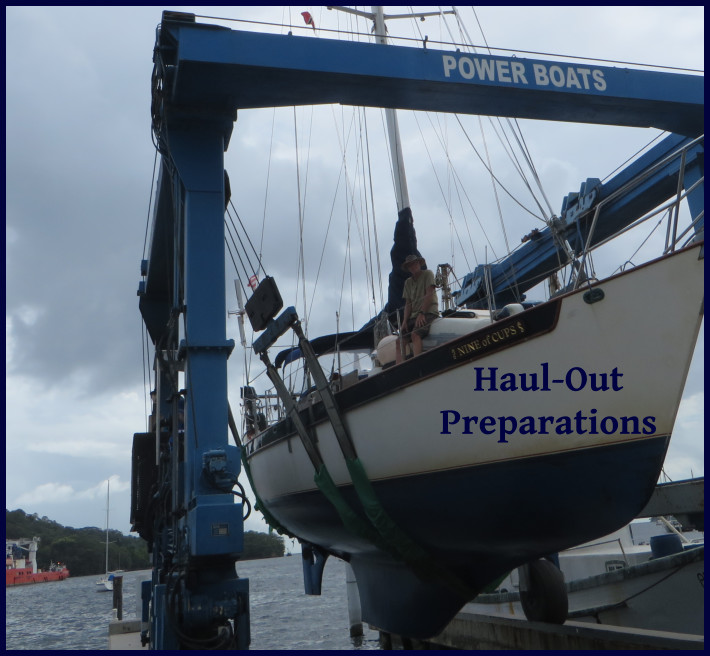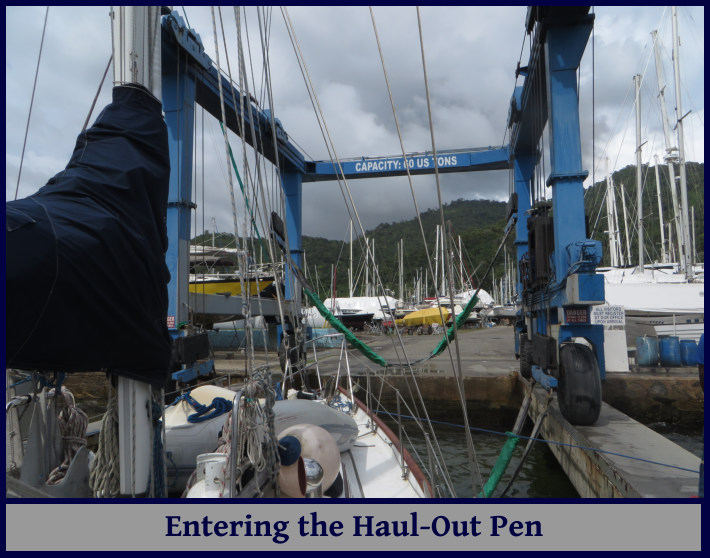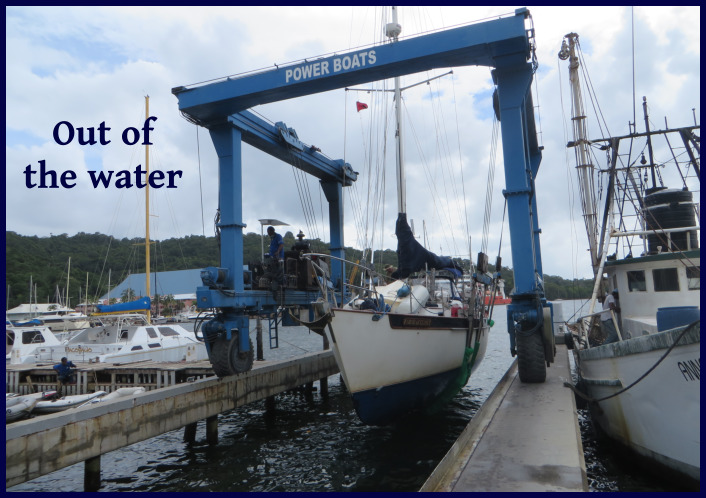The Blue View - Hauling out in Trinidad
/ We hauled out in Trinidad a few days ago. Nine of Cups always looks a little morose when she is on the hard. I don't think she likes sitting on her keel with seven or eight supports holding her upright. Nor does she like having her bottom exposed for any passerby to check out. I think it's sort of like having a physical done in the middle of a busy airport. Hopefully, she will forgive us when we clean and wax her topsides and treat her to fresh bottom paint and a new bootstripe.
We hauled out in Trinidad a few days ago. Nine of Cups always looks a little morose when she is on the hard. I don't think she likes sitting on her keel with seven or eight supports holding her upright. Nor does she like having her bottom exposed for any passerby to check out. I think it's sort of like having a physical done in the middle of a busy airport. Hopefully, she will forgive us when we clean and wax her topsides and treat her to fresh bottom paint and a new bootstripe.
We've hauled out in a lot of different ports around the world, but no matter how many times we do it, I dread the process. The wind always seems to pipe up – or die down - just as I'm trying to maneuver Cups into the narrow concrete pen or the wake from a passing tug generates a big surge at precisely the wrong moment, and poor Cups has a lot of dings and gashes in her teak as a result. That repaired section of the port side caprail? That's from an overzealous marinaro in Venezuela who was helping us into the pen with a dinghy and pushed us into the concrete wall. The big ding on the starboard rub rail? That's my fault when I misjudged the wind as I maneuvered into the pen in Papeete, Tahiti.

Being as prepared as possible helps. Here are the things we do ahead of time to prepare for the haul-out.
Haul-out method. First a caveat. While we have seen several different methods of getting a boat high and dry – everything from careening at high tide, to cranes, to wagons mounted on train tracks that are winched out of the water, we have only ever hauled Cups using a Travelift type of lift.
Reconnaissance. Every place we've been does things differently. Sometimes we are expected to tie up to the walls of the pen while the Travelift maneuvers into position, sometimes the operator 'catches' Cups with the straps as we maneuver into the pen – sometimes there are cleats, sometimes not – sometimes there are 10 men standing by to help fend off, sometimes there's no one – sometimes the operator expects us to have fenders deployed, in other places fenders are a problem. If possible, we visit the facility ahead of time and check with the operator or manager to get as many details as we can. Ideally, we watch another boat being hauled out.
Conditions. Check the wind and current – both on the approach to the pen, as well as in the pen itself. I have the most problem with a current or wind on the beam that is blocked by the pen itself. If I enter the pen too slowly and Cups' stern is still moving downwind or down current while the bow is in the pen, she gets skewed at an angle. If I enter too quickly, a miscalculation on my part will make any damage that much worse. Always a dilemma.
Lift Points. We always provide a diagram of the boat to the lift operator, so he knows what our keel and underwater profile look like. We have lift points marked on the topsides, but different operators using different sized Travelifts often choose to use different lift locations. It's usually not a problem, but if I'm uncomfortable with the operator's decision, I don't hesitate to discuss it.
Headsails. When we were first learning to sail, an instructor once told me that it was a lazy captain who didn't remove his headsails when hauling. Maybe so, and while we do remove our headsails, it isn't because I'm afraid that someone will think I'm a slacker – there are many other indications of my laziness that are all too apparent. Instead, there are a couple of other reasons why I remove the headsails. First, it gives me a chance to inspect the parts of the sail and rigging that aren't visible from the deck. I can check the shackle, eye splices and the section of the halyard that spends most of its life inside the mast. The second reason is that we sometimes have to remove the forestay and baby stay before the Travelift can pick us up (see the next section), and this can't be done on Cups with the headsails furled in place. It is much easier and much less frenetic to remove and stow the sails ahead of time than trying to get the job done in the haul-out pen with the operator and crew glaring at us.
Forestays. Nine of Cups is a 45' cutter, and requires a fairly big Travelift to lift us out of the water. It isn't her weight - she weighs around 20 tons and most Travelifts are big enough to lift this much. It's her size that is at issue. We've found that a Travelift with a capacity less than 50 tons will almost always be too small to lift Cups without first removing the forestay and quite possibly the baby stay as well. We first discovered this after owning Cups a couple of years. We tied up the haul-out facility a couple of hours while I rounded up the necessary tools, used an impact driver to remove a couple of seized screws and figured out how to remove the furler assembly. Quite embarrassing. Having learned that lesson, I now round up all the tools I might need and prepare the forestay for removal ahead of time. I slack off on the backstays, loosen the locknuts on the furler, and loosen or remove any furler parts I can. I also rig a spinnaker line forward to take the strain off the clevis pin holding the forestay so I can remove it without too much drama. I have a couple of old cockpit cushions I use to pad and protect the furler and some short lines to secure it. If I think the baby stay might also have to be removed, I prep it in the same manner.
N.B. Some folks can back into the haul-out pen, but this would require even more effort since we would have to remove both back stays and the wind generator.
Hardware. Anything that could conceivably get in the way of or get damaged by the Travelift is removed and re-positioned. For example, I relocate our dinghy engine so it sits inboard of the lifelines, and tie off the wind generator.
Lines. We always rig two long bow lines and two stern lines. Rather than using our heavy dock lines, we rig lighter weight lines that can be thrown further. They may not be needed, but it's always better to have them rigged and ready, just in case. We keep two other lines – one on each side around midship – flaked out and ready to use. Cups' keel has a sloped forefoot, and although very unlikely, it is possible that the forward lift strap could slide forward as she is being lifted. To eliminate this possibility, we tie a line between the two straps once they are in position.
Fenders. We usually have our fenders rigged and in place as we enter the pen, then pull them back aboard once we are secured. Some facilities discourage them as they may hang up on the straps as we maneuver into the pen. When in doubt, we rig them. We also have a big fat fender we keep at the ready on the foredeck.
Boat hook. We have two boat hooks that can be used for fending off, and keep one lying on the top of the coach roof on each side of the boat.
Disembarking. Occasionally, we are expected to stay aboard while the Travelift lifts us out of the water, but usually the boatyard requests we climb off the boat once the straps are in place and the boat is ready. Sometimes, in a smaller pen, the boat is pulled close enough to the side to disembark that way. Most often Cups is carefully moved forward until the anchor is a few inches from the end of the pen, and we are required to climb over the bow pulpit, and using the anchor as a step, clamber ashore . So far we've been able to accomplish this, if not gracefully, at least without falling into the drink.
Power wash. Once the boat is out of the water, we usually have a power wash done to remove all the sea critters before they dry out and harden. Sometimes we can rent the high pressure washer and do it ourselves, but more often, the boatyard provides the operator. One thing to be aware of is that the operator often shoots the stream of water into the thru-hulls to get all those barnacles out of the hoses and valves. If the thru-hull leads to a sink, the stream of water will shoot up the sink drain and deposit a combination of anti-fouling paint and sea crud on the header above it. We try to remember to close these thru-hulls before the haul-out.

This haul-out went quite well with no new damage or scrapes. The wind kicked up to about 20 knots as we were approaching the pen, but there were two dock hands there to catch our lines and the landing went remarkably well. I'm sure it was due to that tot of rum we gave Neptune on our arrival in Trinidad.

